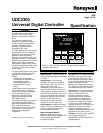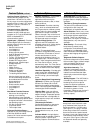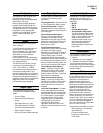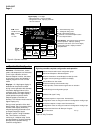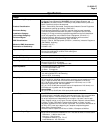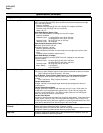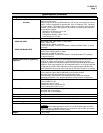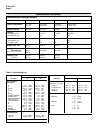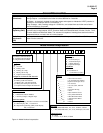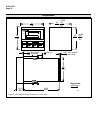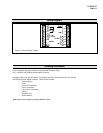
51-52-03-27
Page 3
Configuration
You decide how the controller is to
interact with the process by
selecting, through
simple keystrokes,
the functions you want.
Multi-language prompts guide the
operator step-by-step through
the
configuration process assuring quick
and accurate entry of all configurable
parameters. Five languages are
available via configuration: English,
French, German, Spanish and
Italian.
Inputs
The analog inputs are sampled six
times a second.
The UDC 2300 is available with one
or two inputs. The first input, or
Process Variable input, can be one
of the various thermocouple, RTD,
Radiamatic or linear actuations.
Linear actuations have
thermocouple, RTD, and Radiamatic
transmitter characterization capability
as a standard feature.
The optional second input is a high
level input and accepts ranges of
0-5V, 1-5V, 0-20mA, or 4-20mA.
All actuations and characterizations
are keyboard configurable. Cold
junction compensation is provided for
thermocouple type inputs. Upscale or
downscale sensor break protection is
keyboard configurable. A configurable
digital filter of 0 to 120 seconds
provides input signal damping.
Output Types
The following output types are
available per the model selection
guide:
• Current Output
• Electromechanical Relays (5
amps)
• Solid State Relays (1 amp)
• Solid State Relays (10 amps)
externally mounted (optional)
• Open Collector Outputs
• Auxiliary Current Output (optional)
Output Algorithms
The UDC 2300 is available with one
or more of the following output
algorithms:
Time Proportional—Provides On-Off
or Time Proportional (Relay) output.
Current Proportional—Supplies
proportional direct current output for
final control elements which require a
4-20 mA signal.
Current Proportional Duplex—
Similar to current proportional but
provides a second set of tuning
parameters and a split range current
output or a second current output via
the Auxiliary output option, for the
heat and cool zones.
Time Proportional Duplex—
Depending on which control algorithm
you select, this duplex output
algorithm can provide On-Off Duplex,
Time Proportional Duplex, or Three
Position Step Control. The time
proportional duplex output provides
independent PID tuning constants and
two time proportional outputs; one for
heat zone above the 50% output, and
one for cool zone below 50% output.
Current/Relay Duplex (Relay =
Heat)—A variation of Duplex with
Current active for 0 to 50% output
(PID Set 2) and Relay 2 active 50
to100% output (PID Set 1). Note that
only one alarm is available.
Relay/Current Duplex (Relay =
Cool)—A variation of Duplex with
Current active for 50 to 100% output
and Relay 2 is active for 0 to 50%
output. Not that only one alarm is
available.
Universal Output Model—Flexibility
of the output algorithms allows the
current output with two alarms model
(DC230B-CE) to also be configured
for current simplex, current duplex,
and time simplex. A relay output
model with auxiliary output option
(DC230B-CE-2) can also be
configured for these output
algorithms. Note that only current
simplex and current duplex can have
2 alarms.
Control Algorithms
Depending on the output algorithms
specified, the controller can be
configured for the following control
algorithms:
• On-Off
• PID-A
• PID-B
• PD with Manual Reset
• Three Position Step Control
The Three Position Step Control
algorithm allows the control of a
valve (or other actuator), with an
electric motor driven by two
controller output relays; one to
move the motor upscale, the
other downscale without a
feedback slidewire linked to the
motor shaft.
Control Modes
The controller is capable of operating
in three different control modes:
1. Manual
2. Automatic with Local Setpoint
3. Automatic with Remote Setpoint
The manual and automatic control
modes with local and remote setpoint,
and bumpless, balanceless transfer
between modes.
Alarms
Alarm output terminals are located at
the rear terminal panel. One or two
electromechanical alarm relays are
available to activate external
equipment when preset alarm
setpoints are reached. Each of the
two alarms can be set to monitor two
independent setpoints. Each alarm
setpoint can be either high or low
alarm. The alarm type can be
selected to be either of the inputs,
the Process Variable, Deviation,
Output, Shed from communications,
PV rate of change, or to alarm on
manual mode. It can also be used as
an On or Off event at the beginning
or end of a Ramp/Soak segment.
The alarm hysteresis is configurable
from 0 to 100% of range.
Configurable alarm features include:
•Alarm latching or non-latching
•Alarm blocking
•PV rate of change alarm
•Loop break alarm (Future)
•Timer reset



